Characteristics of Ocean Waves in the Southern Ocean and Seasonal Prediction of Difficulty for the Vessels Crossing the Westerlies
Abstract
:1. Introduction
2. Data and Methods of Analysis
2.1. ERA5 Reanalysis Data
2.2. Hindcast Data
2.3. Routes for PSRV
3. Results
3.1. Characteristics of Waves in the Southern Ocean
3.2. Statistical Characteristics of Time Windows Crossing the Westerlies
3.3. Estimating the Windows for Crossing the Westerlies
4. Conclusions and Discussion
Author Contributions
Funding
Institutional Review Board Statement
Informed Consent Statement
Data Availability Statement
Acknowledgments
Conflicts of Interest
References
- Kennicutt, M.; Chown, S.; Cassano, J.; Liggett, D.; Massom, R.; Peck, L.; Rintoul, S.; Storey, J.; Vaughan, D.; Wilson, T.; et al. Polar research: Six priorities for Antarctic science. Nature 2014, 512, 23–25. [Google Scholar] [CrossRef] [PubMed] [Green Version]
- Solomon, S. Stratospheric ozone depletion on Antarctic ozone. Rev. Geophys. 1999, 37, 275–316. [Google Scholar] [CrossRef]
- Turner, J.; Barrand, N.E.; Bracegirdle, T.J.; Convey, P.; Hodgson, D.A.; Jarvis, M.; Jenkins, A.; Marshall, G.; Meredith, M.P.; Roscoe, H.; et al. Antarctic climate change and the environment: An update. Polar Rec. 2013, 50, 237–259. [Google Scholar] [CrossRef] [Green Version]
- Kennicutt II, M.C.; Bromwich, D.; Liggett, D.; Njastad, B.; Peck, L.; Rintoul, S.R.; Ritz, C.; Siegert, M.J.; Aitken, A.; Brooks, C.M.; et al. Sustained Antarctic research: A 21st century imperative. One Earth 2019, 1, 95–113. [Google Scholar] [CrossRef] [Green Version]
- Orsi, A.H.; Johnson, G.C.; Bullister, J.L. Circulation, mixing, and production of Antarctic bottom water. Prog. Oceanogr. 1999, 43, 55–109. [Google Scholar] [CrossRef]
- Marshall, G.J.; Speer, K. Closure of the meridional overturning circulation through Southern Ocean upwelling. Nat. Geosci. 2012, 5, 171–180. [Google Scholar] [CrossRef] [Green Version]
- Young, I.R.; Fontaine, E.; Liu, Q.X.; Babanin, A.V. The Wave Climate of the Southern Ocean. J. Clim. 2020, 33, 1417–1433. [Google Scholar] [CrossRef] [Green Version]
- Young, I.R.; Ribal, A. Multi-platform evaluation of global trends in wind speed and wave height. Science 2019, 364, 548–552. [Google Scholar] [CrossRef]
- Meucci, A.; Young, I.R.; Aarnes, O.J.; Breivik, O. Comparison of wind speed and wave height trends from twentieth century models and satellite altimeters. J. Clim. 2020, 33, 611–624. [Google Scholar] [CrossRef]
- Wei, L.X.; Qin, T. Characteristics of cyclone climatology and variability in the Southern Ocean. Acta Oceanol. Sin. 2016, 35, 59–67. [Google Scholar] [CrossRef]
- Zheng, C.; Li, C.; Wu, H.; Wang, M. Wind-Sea, Swell and Mixed Wave Energy. In 21st Century Maritime Silk Road: Construction of Remote Islands and Reefs; Springer Oceanography: Singapore, 2019. [Google Scholar]
- Semedo, A.; Sušeljet, K.; Rutgersson, A.; Sterl, A. A global view on the wind sea and swell climate and variability from ERA-40. J. Clim. 2011, 24, 1461–1479. [Google Scholar] [CrossRef]
- Gong, D.Y.; Wang, S.W. Definition of Antarctic oscillation index. Geophys. Res. Lett. 1999, 26, 459–462. [Google Scholar] [CrossRef] [Green Version]
- Pezza, A.B.; Rashid, H.A.; Simmonds, I. Climate links and recent extremes in Antarctic sea ice, high-latitude cyclones, Southern Annular Mode and ENSO. Clim. Dyn. 2012, 38, 57–73. [Google Scholar] [CrossRef]
- Sun, H.L.; Qin, T.; Wei, L.X.; Wang, L.; Ma, J. A statistical analysis on cyclonic gale processes along Chinese Antarctic Research Expedition routes. Haiyang Xuebao 2020, 42, 54–66. (In Chinese) [Google Scholar]
- Hersbach, H.; Bell, B.; Berrisford, P.; Hirahara, S.; Horányi, A.; Muñoz-Sabater, J.; Nicolas, J.; Peubey, C.; Radu, R.; Schepers, D.; et al. The ERA5 global reanalysis. Q. J. Roy. Meteorol. Soc. 2020, 146, 1999–2049. [Google Scholar] [CrossRef]
- Takbash, A.; Young, I. Long-term and seasonal trends in global wave height extremes derived from ERA-5 reanalysis data. J. Mar. Sci. Eng. 2020, 8, 1015. [Google Scholar] [CrossRef]
- Timmermans, B.; Gommenginger, C.; Dodet, G.; Bidlot, J. Global wave height trends and variability from new multimission satellite altimeter products, re-analyses, and wave buoys. Geophys. Res. Lett. 2020, 47, e2019GL086880. [Google Scholar] [CrossRef]
- Nielsen, U.D.; Ikonomakis, A. Wave conditions encountered by ships—A report from a larger shipping company based on ERA5. Ocean Eng. 2021, 237, 109584. [Google Scholar] [CrossRef]
- Merryfield, W.J.; Lee, W.S.; Boer, G.J.; Kharin, V.V.; Scinocca, J.F.; Flato, G.M.; Ajayamohan, R.S.; Fyfe, J.C.; Tang, Y.M.; Polavarapu, S. The Canadian seasonal to interannual prediction system. Part I: Models and initialization. Mon. Weather Rev. 2013, 141, 2910–2945. [Google Scholar] [CrossRef]
- Côté, J.; Gravel, S.; Méthot, A.; Patoine, A.; Roch, M.; Staniforth, A. The operational CMC-MRB Global Environmental Multiscale (GEM) model. Part I: Design considerations and formulation. Mon. Weather Rev. 1998, 126, 1373–1395. [Google Scholar] [CrossRef]
- Kirtman, B.P.; Min, D.; Infanti, J.M.; Kinter III, J.L.; Paolino, D.A.; Zhang, Q.; van den Dool, H.; Saha, S.; Mendez, M.P.; Becker, E.; et al. The North American Multimodel Ensemble: Phase-1 Seasonal-to-Interannual Prediction; Phase-2 toward Developing Intraseasonal Prediction. Bull. Am. Meteorol. Soc. 2014, 95, 585–601. [Google Scholar] [CrossRef]
- China Concludes 38th Antarctic Expedition. Available online: http://en.people.cn/n3/2022/0427/c90000-10089775.html (accessed on 10 May 2022).
- Müller, F.; Schøyen, H. Polar research and supply vessel capabilities-An exploratory study. Ocean Eng. 2021, 224, 108671. [Google Scholar] [CrossRef]
- Young, I.R. Seasonal variability of the global ocean wind and wave climate. Int. J. Climatol. 1999, 19, 931–950. [Google Scholar] [CrossRef]
- Han, S.Z.; Zhang, H.R.; Zheng, Y.X. A global study of temporal and spatial variation of SWH and wind speed and their correlation. Acta Oceanol. Sin. 2014, 33, 48–54. [Google Scholar] [CrossRef]
- Marshall, G.J. Trends in the Southern Annular Mode from observations and reanalyses. J. Clim. 2003, 16, 4134–4143. [Google Scholar] [CrossRef]
- Bender, F.A.M.; Ramanathan, V.; Tselioudis, G. Changes in extratropical storm track cloudiness 1983–2008: Observational support for a poleward shift. Clim. Dyn. 2012, 38, 2037–2053. [Google Scholar] [CrossRef] [Green Version]
- Lubin, D.; Wittenmyer, R.A.; Bromwich, D.H.; Marshall, G.J. Antarctic Peninsula mesoscale cyclone variability and climatic impacts influenced by the SAM. Geophys. Res. Lett. 2008, 35, L02808. [Google Scholar] [CrossRef] [Green Version]
- Uotila, P.; Vihma, T.; Tsukernik, M. Close interactions between the Antarctic cyclone budget and large-scale atmospheric circulation. Geophys. Res. Lett. 2013, 40, 3237–3241. [Google Scholar] [CrossRef]
- Gao, H. Seasonal and Interannual Variations of the Southern Hemisphere Circulation and Their Influences on East Asian Summer Monsoon; Nanjing Institute of Meteorology: Nanjing, China, 2004; pp. 1–171. (In Chinese) [Google Scholar]

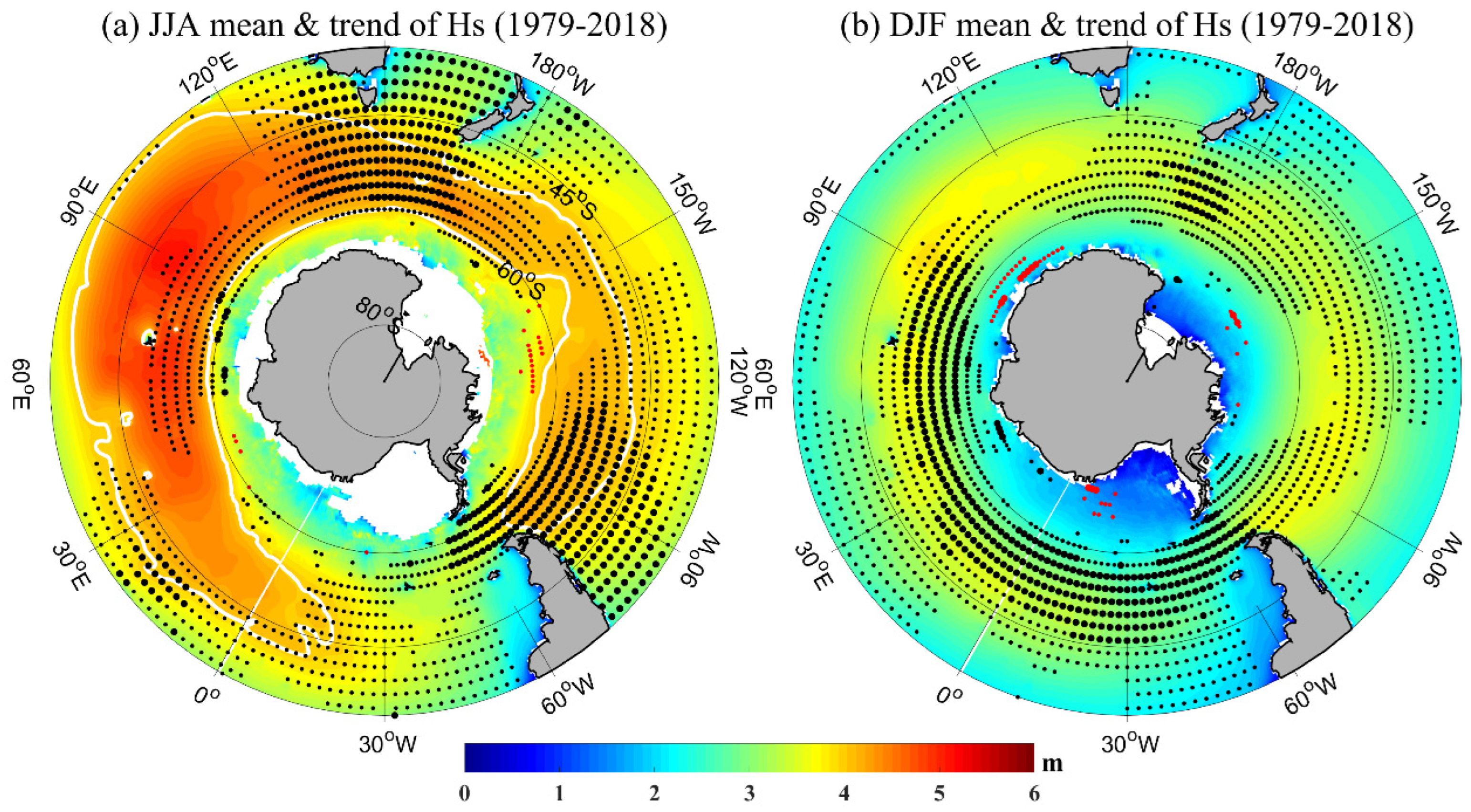
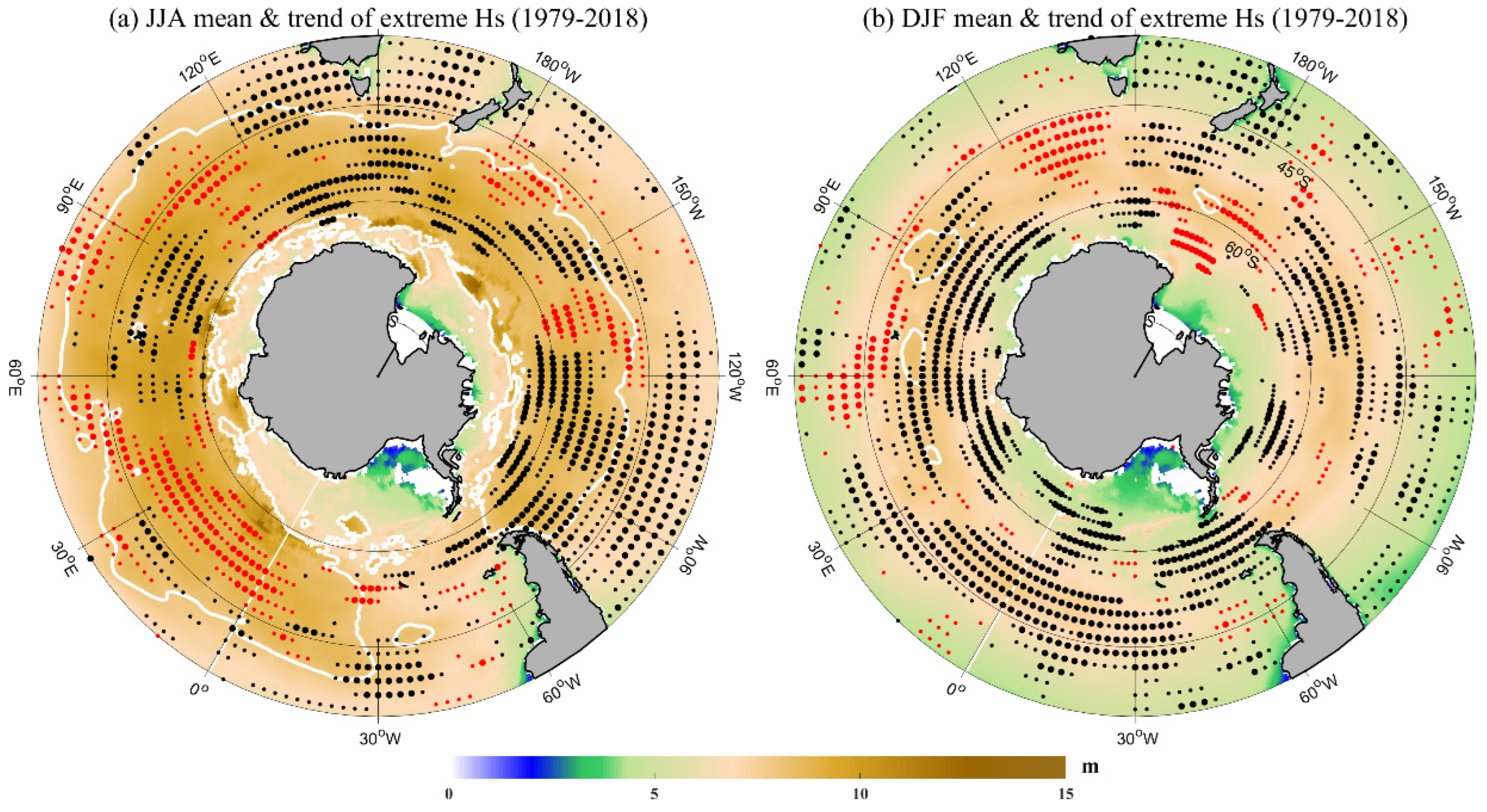
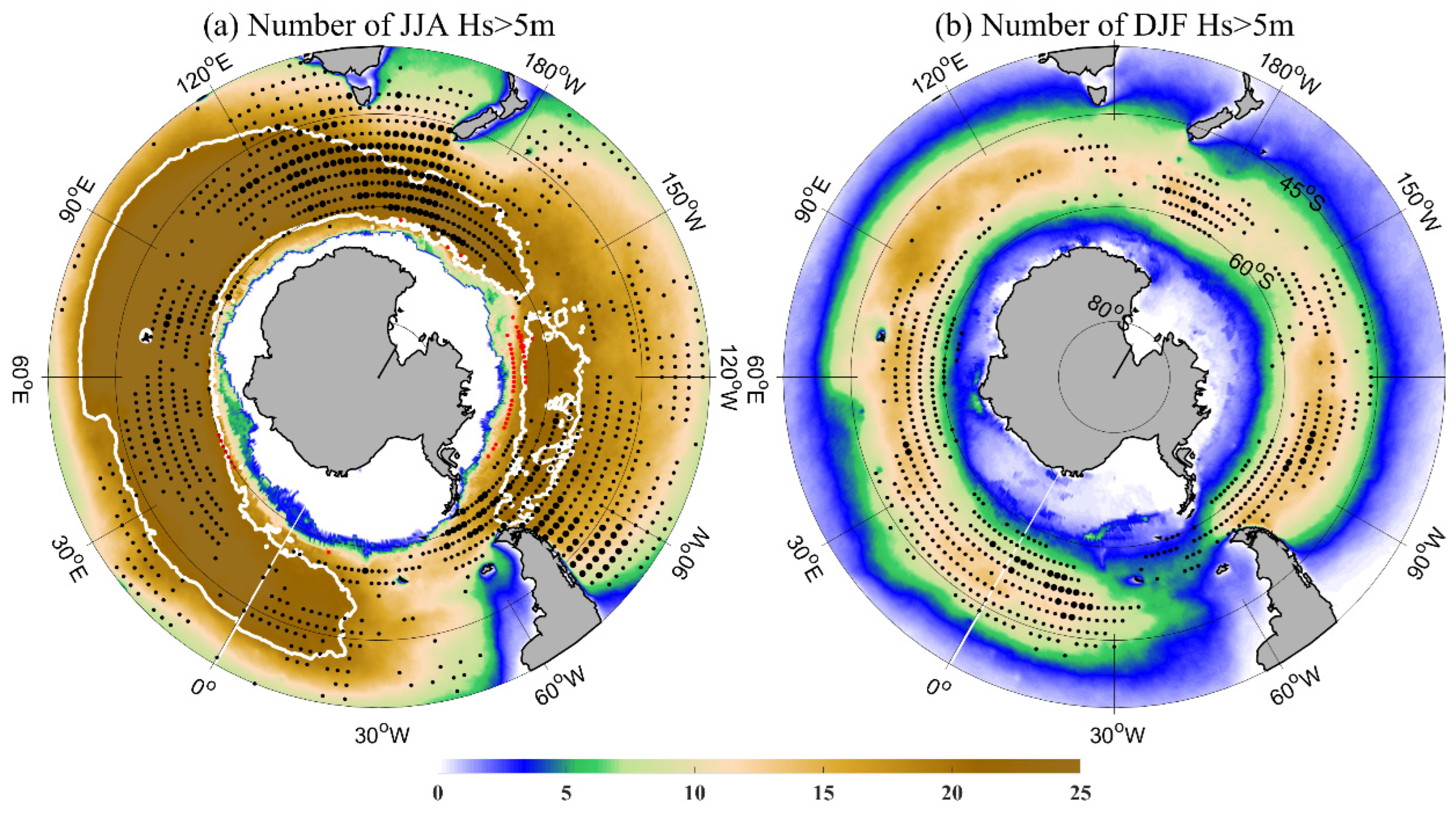
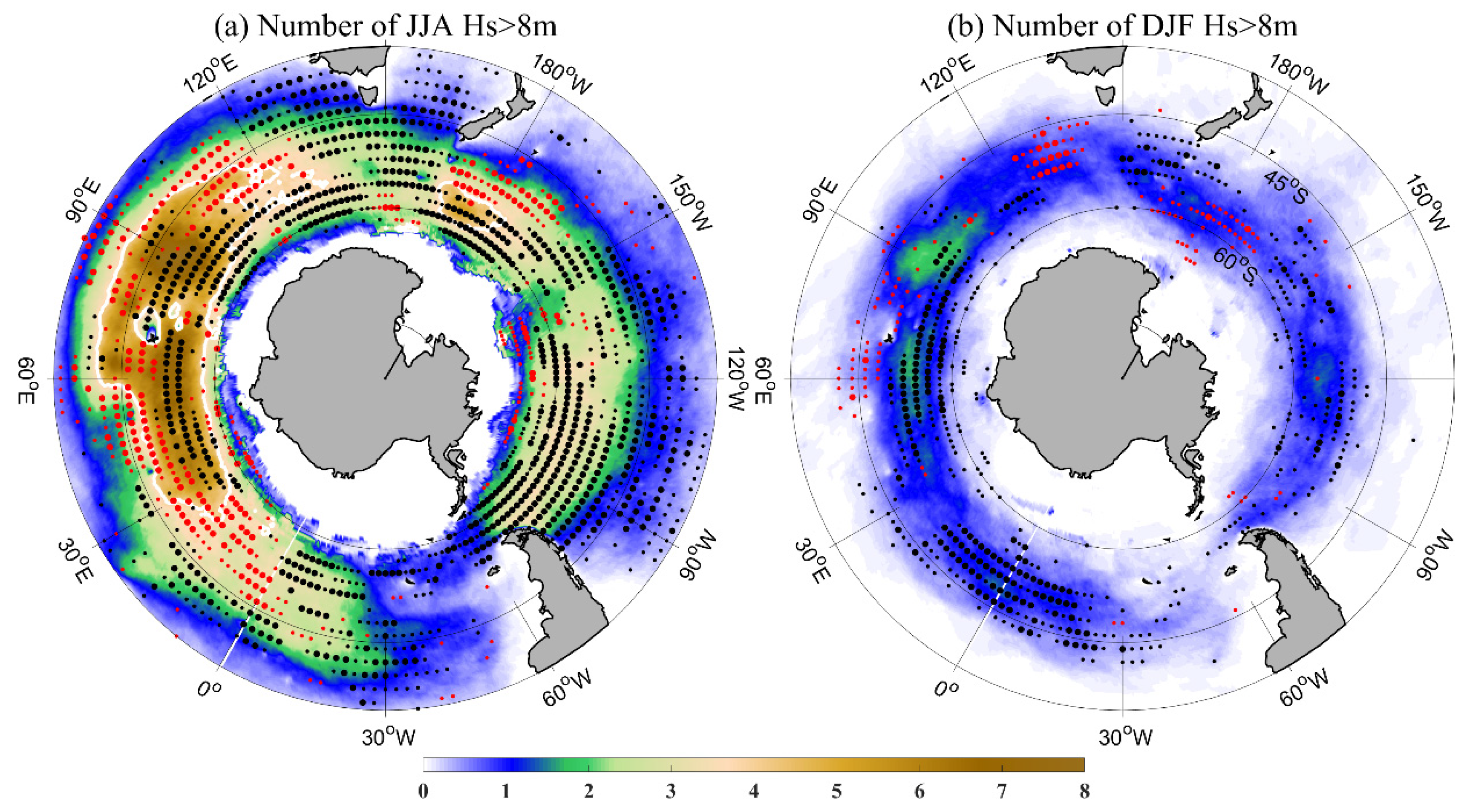


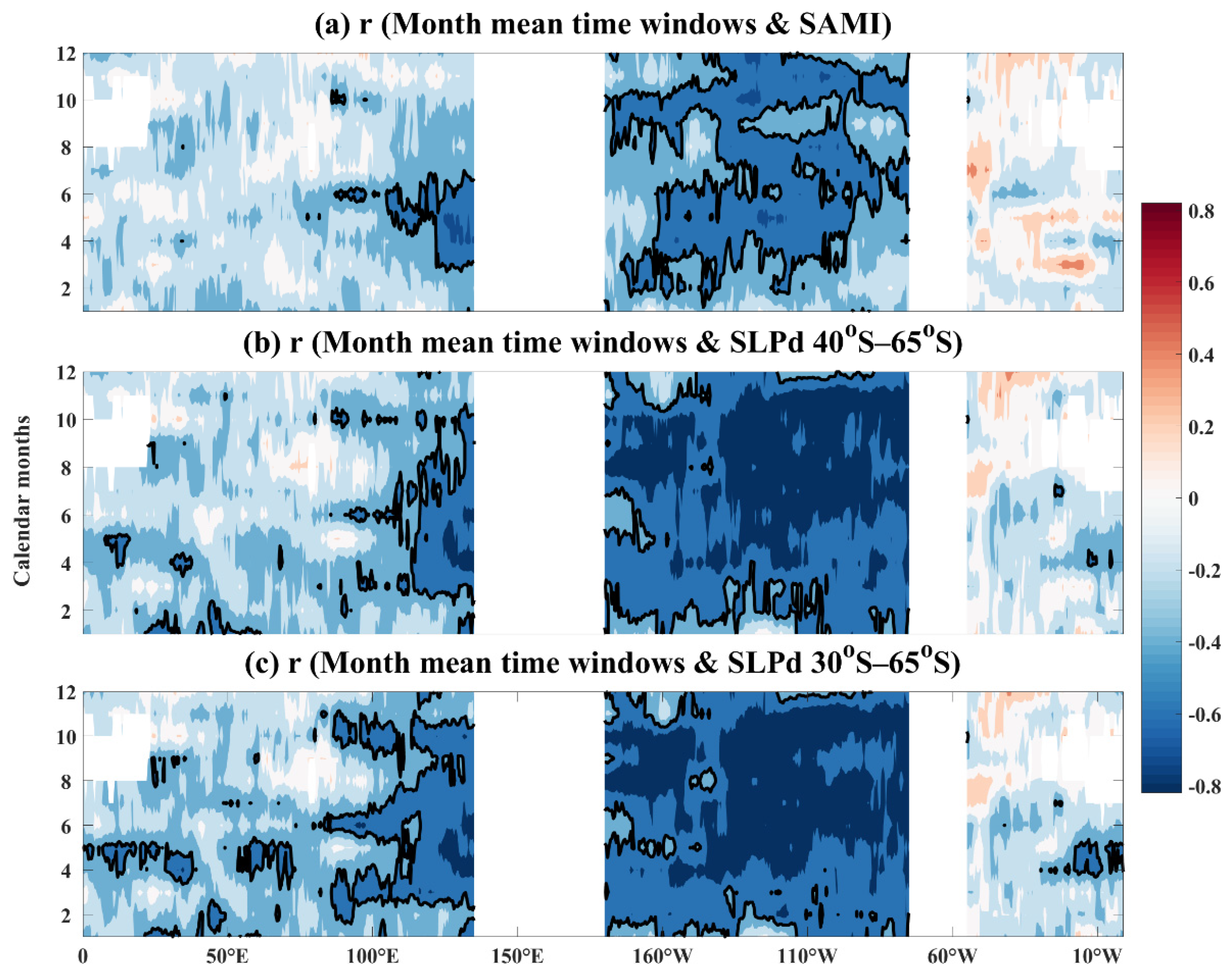
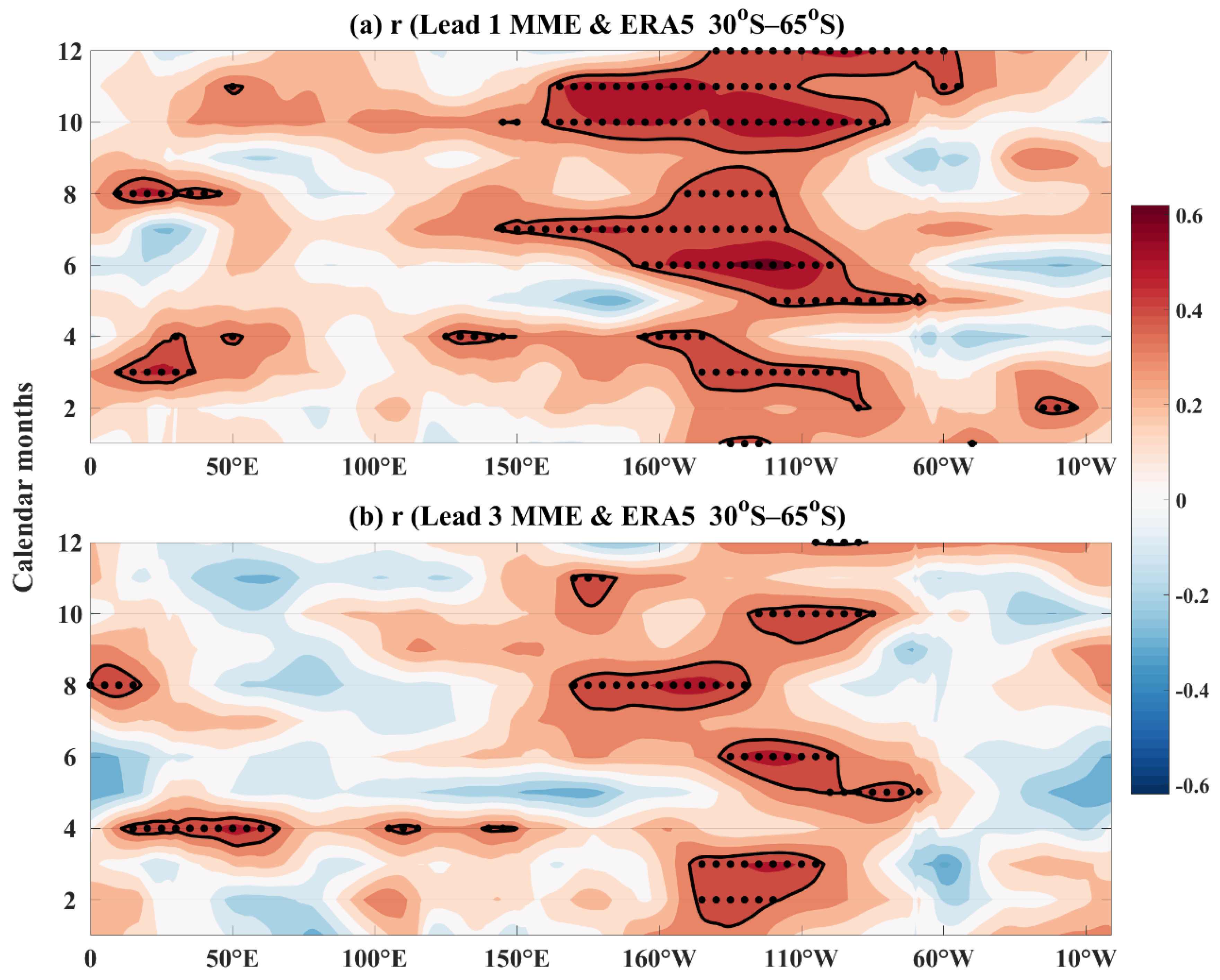
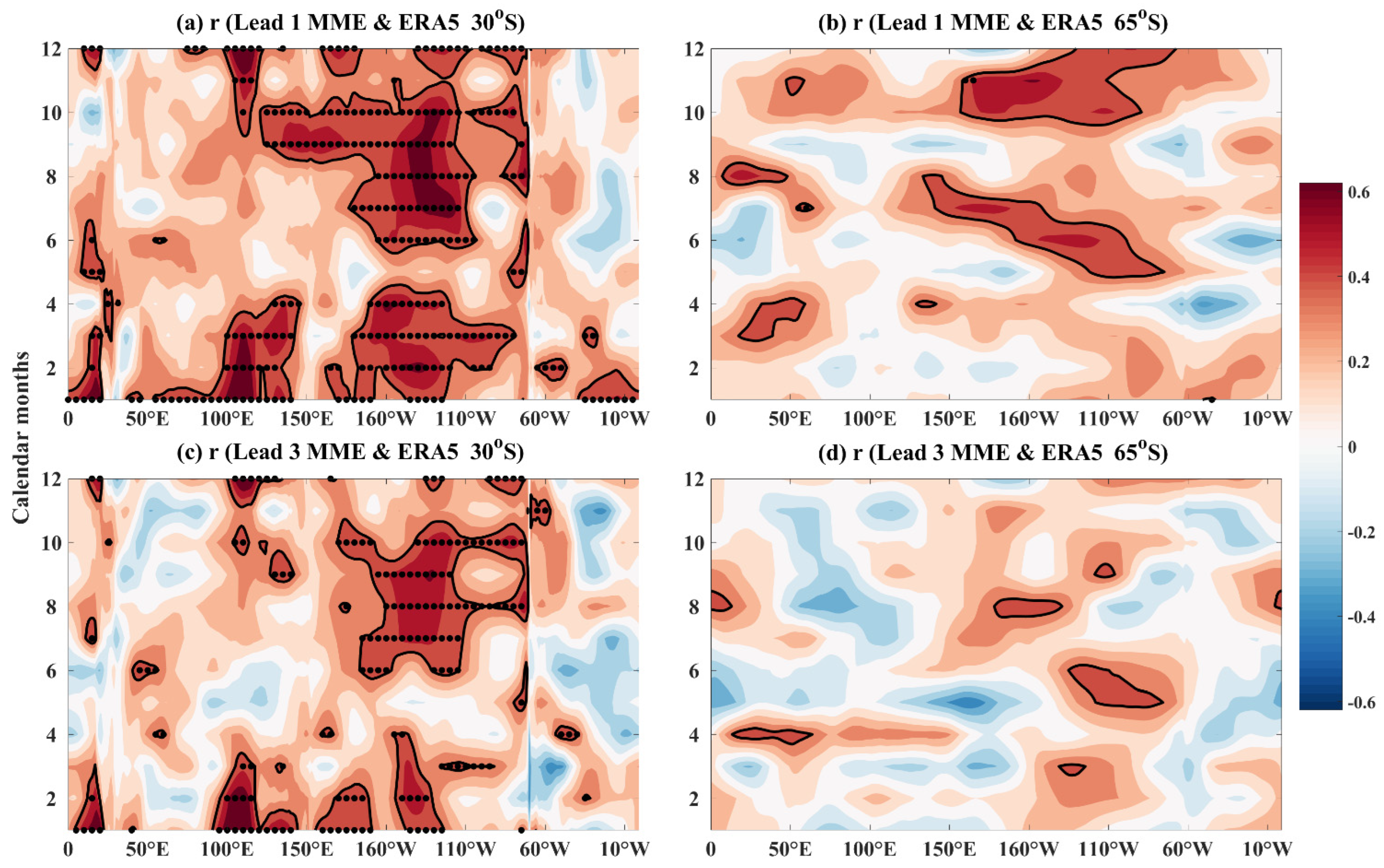
Publisher’s Note: MDPI stays neutral with regard to jurisdictional claims in published maps and institutional affiliations. |
© 2022 by the authors. Licensee MDPI, Basel, Switzerland. This article is an open access article distributed under the terms and conditions of the Creative Commons Attribution (CC BY) license (https://creativecommons.org/licenses/by/4.0/).
Share and Cite
Zhang, S.; Jiang, H.; Yin, Y. Characteristics of Ocean Waves in the Southern Ocean and Seasonal Prediction of Difficulty for the Vessels Crossing the Westerlies. Atmosphere 2022, 13, 916. https://doi.org/10.3390/atmos13060916
Zhang S, Jiang H, Yin Y. Characteristics of Ocean Waves in the Southern Ocean and Seasonal Prediction of Difficulty for the Vessels Crossing the Westerlies. Atmosphere. 2022; 13(6):916. https://doi.org/10.3390/atmos13060916
Chicago/Turabian StyleZhang, Shouwen, Hua Jiang, and Yichen Yin. 2022. "Characteristics of Ocean Waves in the Southern Ocean and Seasonal Prediction of Difficulty for the Vessels Crossing the Westerlies" Atmosphere 13, no. 6: 916. https://doi.org/10.3390/atmos13060916
APA StyleZhang, S., Jiang, H., & Yin, Y. (2022). Characteristics of Ocean Waves in the Southern Ocean and Seasonal Prediction of Difficulty for the Vessels Crossing the Westerlies. Atmosphere, 13(6), 916. https://doi.org/10.3390/atmos13060916




